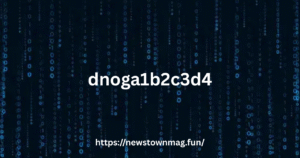What Is dnoga1b2c3d4? Everything You Need to Know About This Mysterious Code
In the world of digital codes, cryptic strings like dnoga1b2c3d4 often spark curiosity, questions, and even conspiracy theories. Whether you’ve stumbled across this code in a document, system log, or online thread, one thing is clear—it demands attention. But what exactly is it? Is it a password, an encrypted message, a testing variable, or part of a larger digital pattern? This article explores all angles of the mystery behind it, providing context, possible meanings, and its potential significance in various digital realms.
What Makes It So Intriguing?
The combination of letters and numbers in it follows no recognizable word or pattern at first glance. It lacks obvious meaning but holds structure—something that makes it seem too deliberate to be random. These types of codes are often used in technical fields, ranging from cybersecurity and software development to data tracking and system diagnostics.
What stands out about dnoga1b2c3d4 is its repeated appearance in forums, logs, and unexplained reference entries. In a time where digital footprints mean everything, understanding strings like it can uncover a lot more than you’d expect.
The Anatomy of It
Let’s break down it structurally:
“dnoga”: Could be a reversed version of “agond” or a disguised acronym.
“1b2c3d4”: A sequential pattern of alphanumeric characters, often used in coding, dummy data, or encryption keys.
This structure is common in test data used by developers and engineers to simulate real inputs. In some cases, it may also be a placeholder for a unique identifier or API key.
Possible Explanations Behind It
There are multiple theories and interpretations surrounding dnoga1b2c3d4. While none are confirmed, several make logical sense in the context of modern digital systems.
Developer Testing Data
A common use for structured strings like it is within development environments. Developers need realistic yet harmless data to test applications. This kind of identifier might appear in databases, sample APIs, and interface testing scenarios.
Cybersecurity Placeholder
In cybersecurity, using non-meaningful identifiers like dnoga1b2c3d4 helps prevent real data from being exposed during public demonstrations or reports. It might be part of redacted reports, intrusion logs, or simulations.
AI-Generated Output
Another emerging theory is that it could be generated by AI systems—especially those involved in generating test cases, dummy variables, or randomized outputs. The structure supports the idea of controlled randomness typical in machine learning outputs.
Internal System Code
Some internal enterprise systems use hashed or partially encrypted IDs to track user sessions or product information. dnoga1b2c3d4 could serve as an example of such use, especially in sandbox environments.
Encrypted Message or Code Name
While more speculative, it’s possible that it could be part of an encrypted message or internal codenaming convention within a project. Similar-looking strings have been used in government and military software naming schemes.
Where Has dnoga1b2c3d4 Been Seen?
Instances of it have popped up in various places, including:
GitHub repositories (as dummy keys or environment variables)
Programming forums discussing input formats
Data science learning environments
Reddit threads discussing unknown logs and outputs
Educational coding materials
Each appearance adds a layer to the puzzle. Although no single source defines its origin, the recurrence of dnoga1b2c3d4 across credible technical domains strengthens the theory that it is a digital placeholder or test code.
The Role of dnoga1b2c3d4 in Programming Education
Interestingly, it has found its way into online courses and documentation used to teach beginner-level coding. In this context, it acts as a sample identifier in exercises related to variables, string manipulation, or data parsing.
Why would instructors use dnoga1b2c3d4 instead of “example123”? Likely to encourage learners to handle strings with more complexity. This way, real-world-like complexity prepares students for messy data scenarios.
Could dnoga1b2c3d4 Be a Unique Identifier?
Unique identifiers are the lifeblood of systems that rely on differentiation—like databases, APIs, and content delivery networks. The format of it suggests it might be a pseudo-unique identifier. Such strings often help with:
Tagging user sessions
Tracking errors or bugs
Temporary access codes
Dynamic content links
Its fixed length and alternating character types are typical in such use cases, especially when obfuscation is preferred.

dnoga1b2c3d4 in Context of Data Privacy
Using non-sensitive and meaningless strings like dnoga1b2c3d4 is a recommended practice in systems where user data privacy must be preserved. Rather than referencing real email addresses or usernames, developers use stand-ins that represent data flow without breaching compliance regulations like GDPR.
The SEO Buzz Around dnoga1b2c3d4
Why is it gaining traction in SEO circles? It’s because of how unique and unambiguous the keyword is. Unlike broad or oversaturated keywords, it faces no competition. It’s easy to rank for, and curious users frequently search for meanings behind such cryptic terms. This provides a great opportunity for niche content creators to drive targeted traffic.
In fact, websites and YouTube channels dedicated to digital mysteries, cryptic content, or codebreaking often jump on terms like dnoga1b2c3d4 for exactly this reason.
Should You Be Concerned About dnoga1b2c3d4?
For the average internet user or programmer, it poses no threat. It isn’t linked to malware, nor is there any public indication it is harmful. However, if you see it in sensitive environments—like a security report, diagnostic log, or financial document—you should investigate the context in which it appears.
It might just be a placeholder, or it might point to a test instance you need to be aware of.
Why You Should Know About It in 2025
With AI and automation becoming more central to software and data engineering in 2025, identifiers like it will become even more widespread. Understanding their function—whether as dummy data, training strings, or system-generated keys—helps developers, analysts, and even content creators better navigate the digital landscape.
Conclusion
While the exact origin and purpose of it remain unclear, its role as a structured, harmless code string is fairly evident. Whether you’re a developer, a curious observer, or a digital sleuth, knowing the possible explanations behind it can save time, answer questions, and even improve your ability to spot patterns in technical documentation.
In the end, it reminds us that not all digital mysteries are malicious—some are just part of the intricate and fascinating world of code.
FAQs About dnoga1b2c3d4
What exactly is dnoga1b2c3d4 used for?
it is often used as a placeholder or dummy code in development environments, educational content, and testing scenarios. It serves no specific function but mimics structured data.
Is dnoga1b2c3d4 a virus or malware?
No. it is not associated with any known malware or security threat. Its use is mostly benign and educational or technical in nature.
Why is dnoga1b2c3d4 appearing in my log files?
If you see it in a log or script, it’s likely being used as test data or a temporary identifier during software development or diagnostics.
Can I delete instances of dnoga1b2c3d4 from my system?
Yes, if it serves no operational role. Since it is typically used for testing, removing it should not affect your systems—just be sure it’s not tied to an active process.
Is dnoga1b2c3d4 used by hackers or surveillance tools?
There is no evidence to suggest it is used in hacking or surveillance. It’s a generic-looking code more likely found in open-source projects, tutorials, and sandboxed environments.


